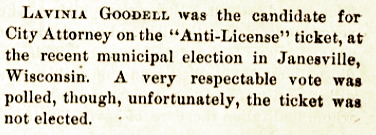Lavinia Goodell’s Bid to Become Janesville City Attorney
Long before anyone asked whether women are “electable,” Lavinia Goodell threw her hat in the ring. This week CUNY professor Jill Norgren, and Swarthmore College Professor Wendy Chmielewski guest post on one of Lavinia’s little known, impressive firsts–1st American woman to run for city attorney. Professors Norgren and Chmielewski co-founded HerHatWasinthe ring.org, a timely digital project about women who ran for office before 1920. Norgren wrote Belva Lockwood: The Woman Who Would be President, a fascinating biography about one of Lavinia’s “sisters in law.“

In April, 1875 attorney Lavinia Goodell ran for public office. She campaigned on the Anti-License or Temperance Party ticket hoping to be elected as the Janesville, Wisconsin city attorney.
Wait! What? In 1875 Wisconsin women could not cast ballots in elections. How, then, could Goodell present herself as a candidate for elective office? Therein, lies one of the most fascinating stories of American political development. Here are the Cliff Notes:
The United States Constitution, ratified in 1788, replaced our nation’s first governing document, the Articles of Confederation. The Articles had created a loose confederation of states with little central authority. With the defects of this confederation apparent, in 1787 members of Congress endorsed a plan for a constitutional convention. But, while the Articles had been a failure, many leaders were not willing to support a new governing document that would leave the states at the mercy of the national government. A compromise was worked out in which certain powers were delegated to the states and others to the central government. The right to determine who could, and could not vote and, by extension, who could run for office was among the important powers delegated to the states. Thus, until the ratification of the Nineteenth (Woman Suffrage) Amendment in 1920 states, counties, and towns determined whether women could vote, and thus be eligible for elected office. Crazy, you say. Well, this arrangement certainly led to a crazy-quilt of female voting prohibitions and, in a few instances, female voting rights and office-holding.
Here is how federalism played out locally before the woman suffrage amendment: In the late nineteenth century, four states – Wyoming, Utah, Colorado and Idaho- gave women full suffrage rights. Beginning in the 1870s, pressure from female educators and suffrage activists led to a number of states or towns to allow women to vote just for school board candidates and on tax and bond issues, and sometimes to run for office. Around the country, a small number of towns also passed laws permitting women to vote in municipal elections. And then, between 1910 and 1918 twelve additional states and territories granted women full suffrage although racial discrimination blocked that right for some.
So this was the history of women’s voting rights, or lack of them, until 1920. What about the closely related question of office holding?
Women announced as candidates for elective office in the United States as early as 1853 knowing that only men could elect them. In the years before the Civil War, the number of women running for offices was tiny. However, in the optimistic political atmosphere of the post-Civil War period aided by the growing woman suffrage movement, more women set out to obtain elective office, believing that the Fourteenth Amendment to the Constitution (ratified in 1868), gave them the right to do so. Data from our digital history project, HerHatWasintheRing.org, show that about sixty percent of these candidacies ran for education-related positions such as town school board member, or county school supervisor. In the 1870s there were also women who campaigned as candidates for various positions including mayor, town clerk, and state senator. In a number of instances, particularly when a female candidate was elected, someone challenged her right to office. A losing male candidate might say that local or state law always used the male pronoun when referring to election procedures, thus prohibiting female candidacies. A few of these challenges found their way to court. Some cases were settled in favor of women. In other instances, judges would cite the existence of the male pronoun, or state baldly that a woman’s place was in her home.
In June 1874 Lavinia Goodell became a member of the Rock County, Wisconsin (circuit court) bar. Because local attorneys would not permit a woman to apprentice in their offices, she had been forced to study on her own. She read the commentaries of noted jurists and made it a regular habit to visit the local circuit court, where she scrutinized the arguments of the attorneys, and the rulings of Judge Herman Conger, formerly a New York State attorney and two-term congressman. She would later handle a number of cases as court-appointed defense counsel.
After joining the bar Goodell’s earliest work involved title searches, debt collection, settlement of an estate, and the preparation of guardianship papers. In August 1874, temperance activists from nearby Fort Atkinson approached her asking to have action taken against two men for the illegal sale of liquor. She was pleased to have the two cases, as they promised nice fees. The work was also a good fit for the daughter of nationally acclaimed temperance activists who was herself a member of the temperance movement.
Goodell’s interest in public office was driven by her commitment to women’s rights and to furthering new temperance laws and regulations. Her selection as the Temperance Party candidate for City Attorney presumably occurred because none of the male members of the Janesville legal bar would run as an anti-liquor candidate. Data from the HerHat project reveal that Goodell was the first woman in the United States to be a candidate for the office of city attorney. Two other women ran for this office before 1920, while several women, beginning in the 1880s, ran for state attorney. Our data show that six women, five of them in Wyoming where women could vote, ran for the office of justice of the peace. Two won.
In the 1875 Janesville election Goodell ran against two male attorneys. She lost to Pliny Norcross, her legal colleague. He received several hundred votes; Lavinia received sixty. But because women could not vote, every ballot cast for her came from a male voter. And the tallies show that she ran ahead of the male temperance candidates for other city offices.

Although Goodell was a trailblazer as a woman lawyer and political candidate, she worried about being a pariah. Women candidates were often accused of being unfeminine or “unsexed”. Goodell used common sense to win the respect of the community, displaying some traditionally “womanly” traits. In a letter to her sister, she wrote that she dressed well, attended an orthodox church, made cakes and preserves, and if she developed “no other alarming eccentricity than a taste for legal studies,” she would be fine and not antagonize the gossips.







